Short description: Surface water is rainwater running off from land surfaces into rivers, lakes and seas which can be collected, stored and utilized through rainwater harvesting.
Introduction to Shallow Ground Water
To the surface water structures to collect and store water belong ponds and earth dams such as Charco dams, Hillside Dams and Valley dams.
1) Charco Dam is suitable for flat land, preferable with a road catchment to supply rainwater run-off.
2) Hillside Dam is the best option for slightly sloping land in places where rainwater flows.
3) Valley Dam can be built in valleys flooded with low floods from small catchments. Although this type of dam is the most cost efficient, it is also the type most easily damaged or washed away by floods if it is not properly designed and constructed.
Charco and Hillside dams are preferably built in circular and oval designs because:
1) They give maximum storage volume for minimum works.
2) The internal and external pressures are evenly distributed and this prevents cave-in of the soil in the walls of the water reservoir.
3) In sandy soils, they can be lined successfully with clayey soil, because the shapes do not have any corners.
Charco dams
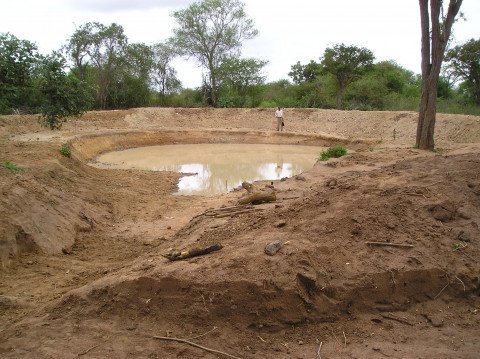
Farmers and cattle owners in semi arid parts of Tanzania build small earth dams known as Charco, or Milambo in Kiswahili. These dams are built in a way, which tries to reduce evaporation losses by deepening the water reservoirs and minimising their surface area. Trees and shrubs are grown on the windy site of the charco dams to function as windbreaks and reduce evaporation.
Site selection:
The best sites for constructing charco dams are in natural depressions where rainwater either flows or accumulates during rainy seasons. The soil should, preferably, be deep clay, silt or Black Cotton Soil. Coarse textured sandy soils should be avoided as these are highly permeable and water will drain through them. If seepage is high in charco dams, they can be plastered with clayey soil and compacted using compactors made of tree trunks.
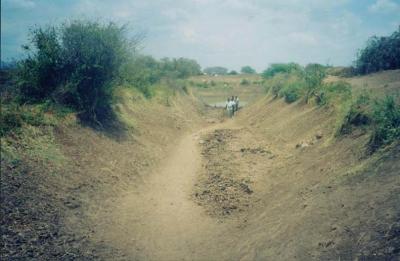 |
| Inflow channel |
| © E. Nissen-Petersen, Kenya |
The photo shows the inflow channel to a charco dam seen in the background. Usually, inflow channels have some logs laid across the floor of the inflow channel functioning as steps and silt traps to prevent the water reservoir from being silted up.
Charco dams are usually excavated manually by individuals near their homesteads for watering livestock. The water may also be used for some domestic purposes, if it is boiled or treated by the Sun's UV rays in transparent bottles (SODIS). For more information on water treatment click here
1) A farmer's financial capacity to hire labourers to assist him excavating.
2) The expected volume of runoff water from the catchment.
3) The area available for constructing the pond.
4) The soil type.
Hillside dams
|
Hillside dams are small earth dams with curved walls built on hillsides and sloping land are the simplest and second cheapest earth dams to locate, design, construct and maintain.
Site selection:Suitable sites for hillside dams can be found on almost any sloping land that produces rainwater runoff. The catchment can include roads, compounds, roofs, agricultural land and rock outcrops. To avoid contamination of the water, there should not be any pollution sources, such as drainage from villages, slaughterhouses, latrines, rubbish pits, cattle dips, etc. in the catchment area. |
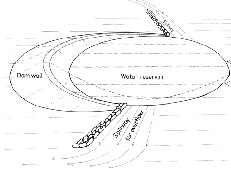 |
| A bird's eye view of a hillside dam |
| © E. Nissen-Petersen, Kenya |
.
The curved heap of soil, shown above, will become the dam wall, while the excavated pit will be the water reservoir. The size of the dam wall and its reservoir depends on the capacity to remove soil from the reservoir and placing it on the dam wall. The gradient (slope) of the sides of the dam wall should be 2:1, which is 2 m width for every 1m of height.
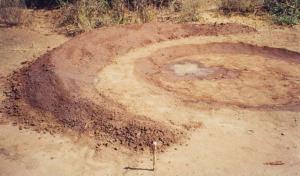
| Curved heap of soil |
| © E. Nissen-Petersen, Kenya |
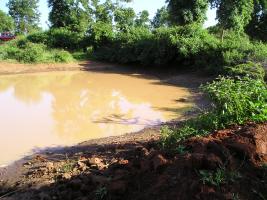 |
| Hill side dam |
| © E. Nissen-Petersen, Kenya |
Valley dams
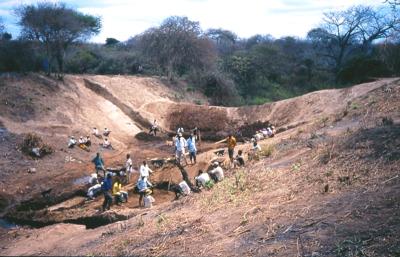 |
| Valley dam |
|
© E. Nissen-Petersen, Kenya
|
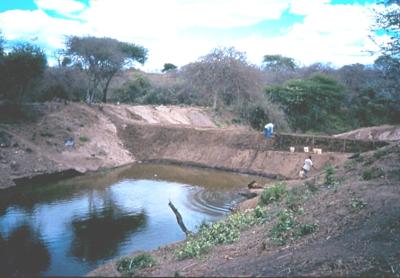 |
| Valley dam |
|
© E. Nissen-Petersen
|
Information Sources
- Chleq, J.- L. and Dupriez, H. (1988). Vanishing Land and Water. Soil and water conservation in dry lands. Land and Life/ Macmillan Press Ltd, London. ISBN 0-333-44597-X
- Nissen-Petersen, E. (1982). Rain Catchment and Water Supply in Rural Africa: A Manual. Hodder and Stoughton, Great Britain. ISBN 0340-28429-3.
- Nissen-Petersen, E. (2000). Water from Sand Rivers. A manual on site survey, design, construction and maintenance of seven types of water structures in riverbeds. RELMA Technical Handbook No.23. Sida Regional Land Management Unit, Nairobi, Kenya. ISBN 9966-896-53-8
- Nissen-Petersen, E. (2006). Water from Dry Riverbeds. How dry and sandy riverbeds can be turned into water sources by hand-dug wells, subsurface dams, weirs and sand dams. ASAL Consultants Ltd. and Danish International Development Assistance (Danida), Kenya.
- Nissen-Petersen, E. (2006). Water from Roads. A handbook for technicians and farmers on harvesting rainwater from roads. ASAL Consultants Ltd. and Danish International Development Assistance (Danida), Kenya.
- Nissen-Petersen, E. (2006). Water from Rock Outcrops. A handbook for engineers and technicians on site investigations, designs, construction and maintenance of rock catchment tanks and dams. ASAL Consultants Ltd. and Danish International Development Assistance (Danida), Kenya.
- Nissen-Petersen, E. (2006). Water from Small Dams. A handbook for technicians, farmers and other on site investigations, designs, cost estimates, construction and maintenance of small earth dams. ASAL Consultants Ltd. and Danish International Development Assistance (Danida), Kenya.
- Nissen-Petersen, E. (2007). Water from Roofs. A handbook for technicians and builders on survey, design, construction and maintenance of roof catchments. ASAL Consultants Ltd. and Danish International Development Assistance (Danida), Kenya.
- Water, Engineering and Development Centre (WEDC) (1998). The worth of water: Technical briefs on health, water and sanitation. IT Publications, London. ISBN 1 85339 069 0
- www.waterforaridland.com
